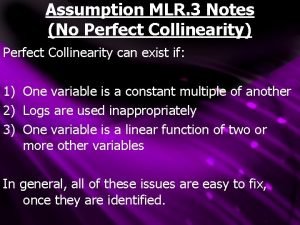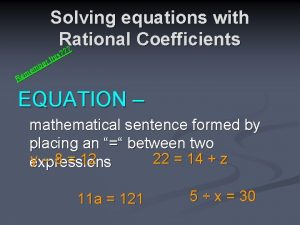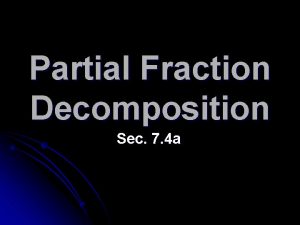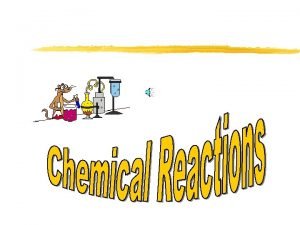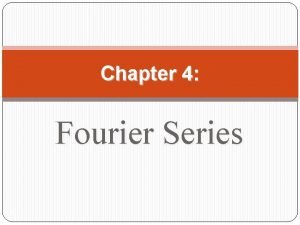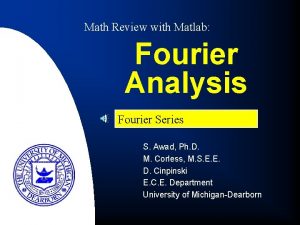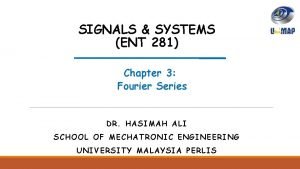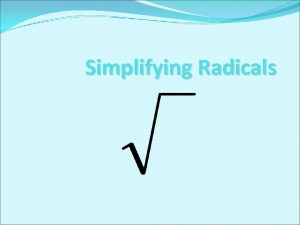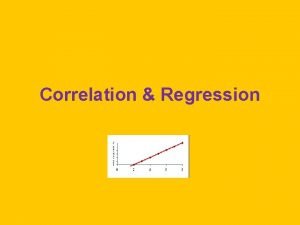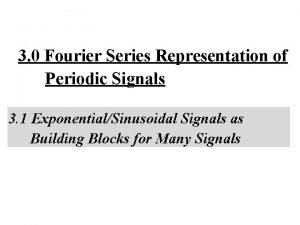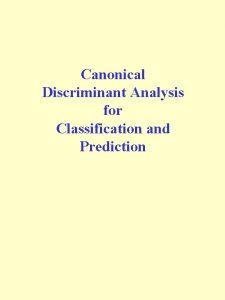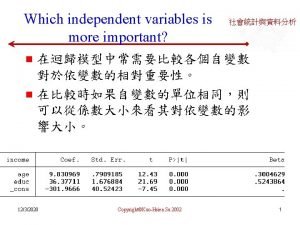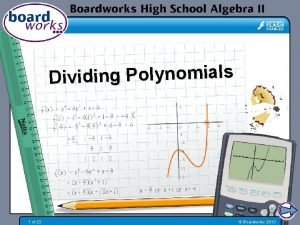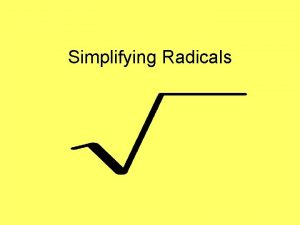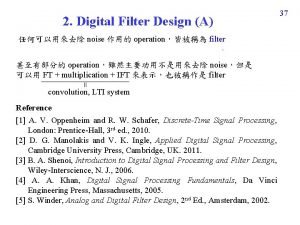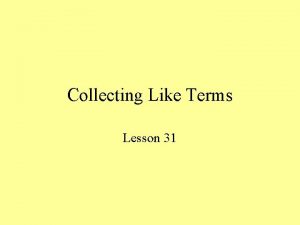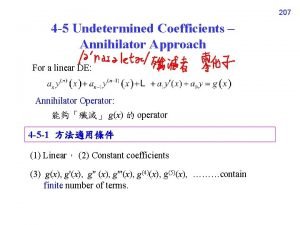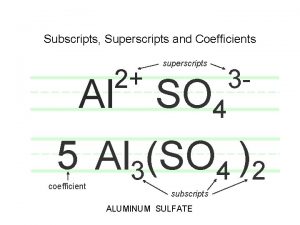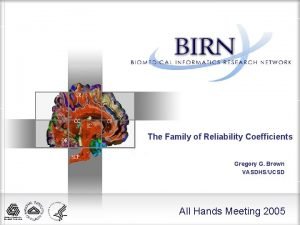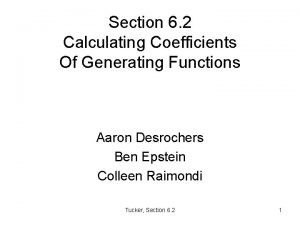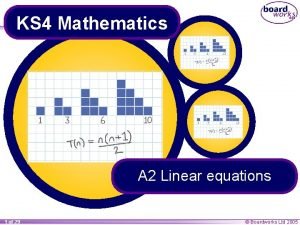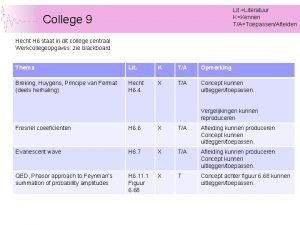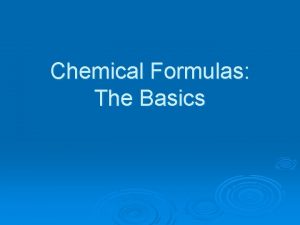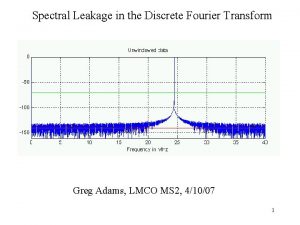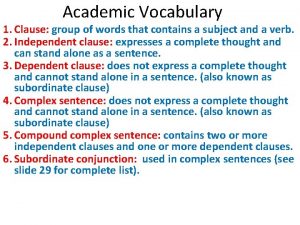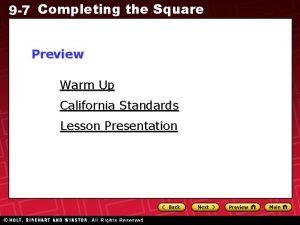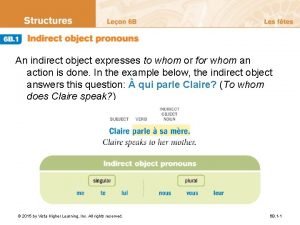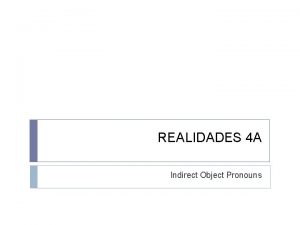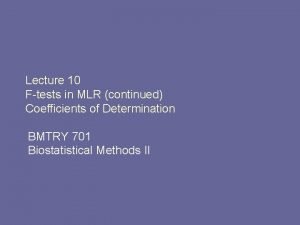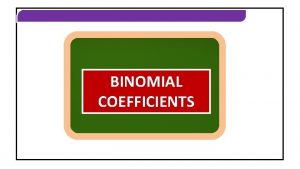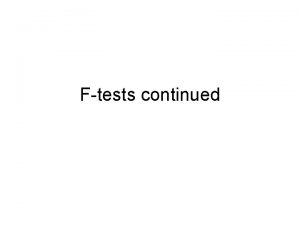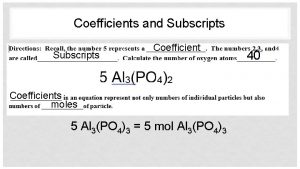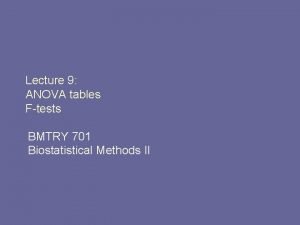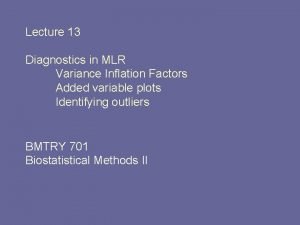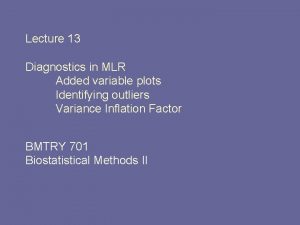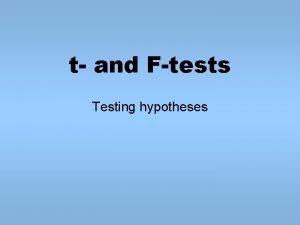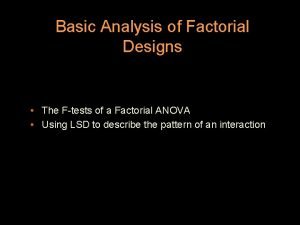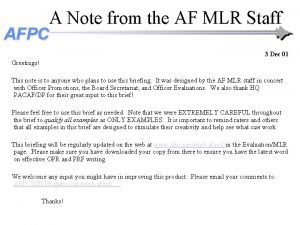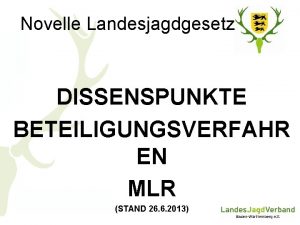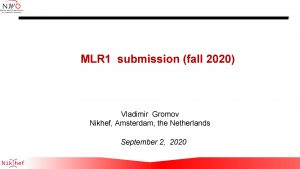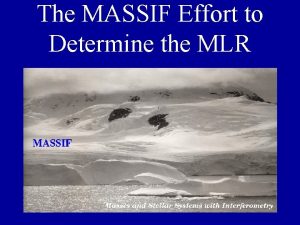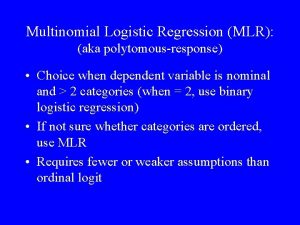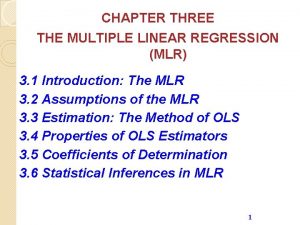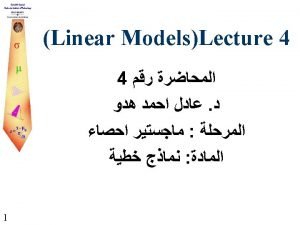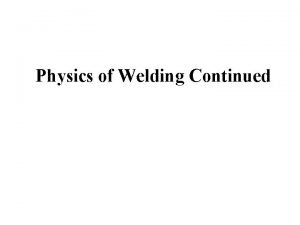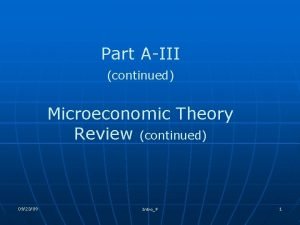Lecture 10 Ftests in MLR continued Coefficients of








































- Slides: 40

Lecture 10 F-tests in MLR (continued) Coefficients of Determination BMTRY 701 Biostatistical Methods II

F-tests continued § Two kinds of F-tests § Overall F-test (or Global F-test) • tests whether or not there is a regression relation between Y and the set of covariates • For a regression with p covariates, the overall F-test compares • F* = MSR/MSE ~ F(p, n-p-1)

Recall earlier example § “Full” model § The overall F-tests if there is some association

> reg 1 <- lm(LOS ~ INFRISK + ms + NURSE + nurse 2, data=data) > anova(reg 1) Analysis of Variance Table Response: LOS Df Sum Sq Mean Sq F value Pr(>F) INFRISK 1 116. 446 45. 4043 8. 115 e-10 *** ms 1 12. 897 5. 0288 0. 02697 * NURSE 1 1. 097 0. 4277 0. 51449 nurse 2 1 1. 789 0. 6976 0. 40543 Residuals 108 276. 981 2. 565 --SSR SSE MSR MSE <<<<- 116. 45 + 12. 90 + 1. 10 + 1. 79 276. 98 SSR/4 SSE/108 Fstar <- MSR/MSE Fstar 1 - pf(Fstar, 4, 108)

But, Global F is part of the “summary” output so no need for the additional calculations > summary(reg 1) Coefficients: Estimate Std. Error t value Pr(>|t|) (Intercept) 6. 355 e+00 5. 266 e-01 12. 068 < 2 e-16 *** INFRISK 6. 289 e-01 1. 339 e-01 4. 696 7. 86 e-06 *** ms 7. 829 e-01 5. 211 e-01 1. 502 0. 136 NURSE 4. 136 e-03 4. 093 e-03 1. 010 0. 315 nurse 2 -5. 676 e-06 6. 796 e-06 -0. 835 0. 405 --Signif. codes: 0 ‘***’ 0. 001 ‘**’ 0. 01 ‘*’ 0. 05 ‘. ’ 0. 1 ‘ ’ 1 Residual standard error: 1. 601 on 108 degrees of freedom Multiple R-squared: 0. 3231, Adjusted R-squared: 0. 2981 F-statistic: 12. 89 on 4 and 108 DF, p-value: 1. 298 e-08

Partial F test § partial because it tests “part” of the model. § tests one or more covariates simultaneously § Can be done using the ANOVA table, if covariates are entered in the ‘correct’ order § Or, by comparing results from regression tables § Examples:

ANOVA tables with 3 covariates SS df MS X 1 X 2|X 1 SS(X 1)/1 SS(X 2|X 1)/1 X 3|X 2, X 1 SS(X 3|X 2, X 1)/1 Error Total SSE n– 4 SSE/(n-4) SST n-1

ANOVA tables with 3 covariates SS df MS Regression X 1 SS(X 1, X 2, X 3) 3 SSR/3 SS(X 1) 1 SS(X 1)/1 X 2|X 1 SS(X 2|X 1)/1 X 3|X 2, X 1 SS(X 3|X 2, X 1)/1 Error Total SSE n– 4 SSE/(n-4) SST n-1 where SS(X 1, X 2, X 3) = SS(X 1) + SS(X 2|X 1) + SS(X 3|X 2, X 1)

Interpretation of ANOVA table with >1 covariate > anova(reg 1) Analysis of Variance Table Response: LOS Df Sum Sq Mean Sq F value Pr(>F) INFRISK 1 116. 446 45. 4043 8. 115 e-10 *** ms 1 12. 897 5. 0288 0. 02697 * NURSE 1 1. 097 0. 4277 0. 51449 nurse 2 1 1. 789 0. 6976 0. 40543 Residuals 108 276. 981 2. 565 SSR(INFRISK) = 116. 446 SSR(ms | INFRISK) = 12. 897 SSR(NURSE| ms, INFRISK) = 1. 097 SSR(nurse 2| nurse, ms, INFRISK) = 1. 789 What are these F-tests and pvalues testing?

F-tests and p-values in ANOVA table § They are tests for a covariate, conditional on what is above it in the table. § Example: • F statistic for INFRISK tests • is it adjusted for other covariates? § no § it tests INFRISK in the presence of no other covariates § p < 0. 0001

F-tests and p-values in ANOVA table § Example: • F statistic for ‘ms’ tests • is it adjusted for other covariates? § yes § it tests the significance of ms, after adjusting for INFRISK § p = 0. 03 § Example: F-statistic for nurse 2 tests significance of β 4, adjusting for INFRISK, ms, NURSE. p = 0. 41

Interpretation of ANOVA table with >1 covariate > reg 1 a <- lm(LOS ~ ms + NURSE + nurse 2 + INFRISK , data=data > anova(reg 1 a) Analysis of Variance Table Response: LOS Df Sum Sq Mean Sq F value Pr(>F) ms 1 36. 084 14. 0699 0. 0002852 *** NURSE 1 17. 178 6. 6980 0. 0109794 * nurse 2 1 22. 421 8. 7425 0. 0038187 ** INFRISK 1 56. 546 22. 0481 7. 857 e-06 *** Residuals 108 276. 981 2. 565 --SSR(ms) = 36. 084 SSR(NURSE| ms) = 17. 178 SSR(nurse 2| ms, NURSE) = 22. 421 SSR(INFRISK| ms, NURSE, nurse 2 ) = 56. 546

Implications § ANOVA table results depends on the order in which the covariates appear § If you want to use ANOVA table to test one or more covariates, they should come at the end § reg 1: • we can see if INFRISK is significant without any adjustments • we can see if nurse 2 is significant adjusting for everything else § reg 1 a: • we can see if INFRISK is significant adjusting for everything else • we can see if nurse 2 is significant, adjusting for NURSE and ms, but not adjusting for INFRISK

F-tests § Global F-test § Partial F-test for ONE covariate

F-tests (continued) § Partial F-test for >1 covariate § Implications: • The denominator is always the MSE from the full model • The numerator can always be determined by entering the covariates in the order in which you want to test them • Recall: additivity of sums of squares

More on the partial F test § Test whether an individual βk = 0 § Test whether a set of βk = 0 § Model 1: § Model 2: § Model 3:

Testing more than two covariates § To test Model 1 vs. Model 3 • we are testing that β 3 = 0 AND β 4 = 0 • Ho: β 3 = β 4 = 0 vs. Ha: β 3 ≠ 0 or β 4 ≠ 0 • If β 3 = β 4 = 0, then we conclude that Model 3 is superior to Model 1 • That is, if we fail to reject the null hypothesis Model 1: Model 3:

Interpretation of ANOVA table with >1 covariate > anova(reg 1) Analysis of Variance Table Response: LOS Df Sum Sq Mean Sq F value Pr(>F) INFRISK 1 116. 446 45. 4043 8. 115 e-10 *** ms 1 12. 897 5. 0288 0. 02697 * NURSE 1 1. 097 0. 4277 0. 51449 nurse 2 1 1. 789 0. 6976 0. 40543 Residuals 108 276. 981 2. 565 SSR(INFRISK) = 116. 446 SSR(ms | INFRISK) = 12. 897 SSR(NURSE| ms, INFRISK) = 1. 097 SSR(nurse 2| nurse, ms, INFRISK) = 1. 789

Using ANOVA table results § SSR(NURSE, nurse 2| INFRISK, ms) = SSR(NURSE| ms, INFRISK) + SSR(nurse 2| nurse, ms, INFRISK) = 1. 097+ 1. 789 = 2. 886 § MSR = 2. 886/2 = 1. 443 § F* = 1. 443/2. 565 = 0. 5626 ~ F(2, 108) § p-value = 0. 57

R: simpler approach > anova(reg 3) Analysis of Variance Table Response: LOS Df Sum Sq Mean Sq F value Pr(>F) INFRISK 1 116. 446 45. 7683 6. 724 e-10 *** ms 1 12. 897 5. 0691 0. 02634 * Residuals 110 279. 867 2. 544 --> anova(reg 1, reg 3) Analysis of Variance Table Model 1: Model 2: Res. Df 1 108 2 110 LOS ~ INFRISK + ms + NURSE + nurse 2 LOS ~ INFRISK + ms RSS Df Sum of Sq F Pr(>F) 276. 981 279. 867 -2 -2. 886 0. 5627 0. 5713

R > summary(reg 3) Call: lm(formula = LOS ~ INFRISK + ms, data = data) Residuals: Min 1 Q Median -2. 9037 -0. 8739 -0. 1142 3 Q 0. 5965 Max 8. 5568 Coefficients: Estimate Std. Error t value Pr(>|t|) (Intercept) 6. 4547 0. 5146 12. 542 <2 e-16 *** INFRISK 0. 6998 0. 1156 6. 054 2 e-08 *** ms 0. 9717 0. 4316 2. 251 0. 0263 * --Signif. codes: 0 ‘***’ 0. 001 ‘**’ 0. 01 ‘*’ 0. 05 ‘. ’ 0. 1 ‘ Residual standard error: 1. 595 on 110 degrees of freedom Multiple R-squared: 0. 3161, Adjusted R-squared: 0. 3036 F-statistic: 25. 42 on 2 and 110 DF, p-value: 8. 42 e-10

Testing multiple coefficients simultaneously § Region: it is a ‘factor’ variable with 4 categories > reg 4 <- lm(LOS ~ factor(REGION), data=data) > anova(reg 4) Analysis of Variance Table Response: LOS Df Sum Sq Mean Sq F value Pr(>F) factor(REGION) 3 103. 554 34. 518 12. 309 5. 376 e-07 *** Residuals 109 305. 656 2. 804 ---

Continued… > summary(reg 4) Coefficients: Estimate Std. Error t value Pr(>|t|) (Intercept) 11. 0889 0. 3165 35. 040 < 2 e-16 *** factor(REGION)2 -1. 4055 0. 4333 -3. 243 0. 00157 ** factor(REGION)3 -1. 8976 0. 4194 -4. 524 1. 55 e-05 *** factor(REGION)4 -2. 9752 0. 5248 -5. 669 1. 19 e-07 *** Residual standard error: 1. 675 on 109 degrees of freedom Multiple R-squared: 0. 2531, Adjusted R-squared: 0. 2325 F-statistic: 12. 31 on 3 and 109 DF, p-value: 5. 376 e-07

Recall previous example § Interaction between REGION and MEDSCHL

How to test the interaction terms? § Approach 1: • Fit two models § model with interactions § model without interactions • Compare models using ‘anova’ command § Approach 2: • • fit one model find SSR for interactions, conditional on main effects calculate F-statistic calculate p-value

Approach 1 > reg 5 <- lm(log. LOS ~ factor(REGION)*ms, data=data) > reg 6 <- lm(log. LOS ~ factor(REGION)+ ms, data=data) > anova (reg 6, reg 5) Analysis of Variance Table Model 1: Model 2: Res. Df 1 108 2 105 > log. LOS ~ factor(REGION) + ms log. LOS ~ factor(REGION) * ms RSS Df Sum of Sq F Pr(>F) 2. 29085 2. 27831 3 0. 01254 0. 1926 0. 9013

Approach 2 > anova(reg 5) Analysis of Variance Table Response: log. LOS Df factor(REGION) 3 ms 1 factor(REGION): ms 3 Residuals 105 - Sum Sq 0. 98268 0. 27393 0. 01254 2. 27831 Mean Sq F value Pr(>F) 0. 32756 15. 0961 3. 077 e-08 *** 0. 27393 12. 6245 0. 0005719 *** 0. 00418 0. 1926 0. 9012545 0. 02170 What are degrees of freedom for the F-test?

Concluding remarks r. e. F-test § Global F-test: not very common, except for very small models § Partial F-test for individual covariate: not very common because it is the same as the t-test § Partial F-test for set of covariates: • quite common • easiest to find ANOVA table for nested models • can use ANOVA table from full model to determine Fstatistic

Coefficient of Determination § Also called R 2 § Measures the variability in Y explained by the covariates. § Two questions (and think ‘sums of squares’ in ANOVA): • How do we measure the variance in Y? • How do we measure the variance explained by the X’s?

R 2 § The coefficient of determination is defined as SSR: Variance explained by X’s SST: Variance in Y SSE: Variance left over, not explained by regression

Use of R 2 § § Similar to correlation But, not specific to just one X and Y Partitioning of explained versus unexplained For certain models, it can be used to determine if addition of a covariate helps ‘predict’

SENIC example > summary(reg 1) Coefficients: Estimate Std. Error t value Pr(>|t|) (Intercept) 6. 355 e+00 5. 266 e-01 12. 068 < 2 e-16 *** INFRISK 6. 289 e-01 1. 339 e-01 4. 696 7. 86 e-06 *** ms 7. 829 e-01 5. 211 e-01 1. 502 0. 136 NURSE 4. 136 e-03 4. 093 e-03 1. 010 0. 315 nurse 2 -5. 676 e-06 6. 796 e-06 -0. 835 0. 405 --Signif. codes: 0 ‘***’ 0. 001 ‘**’ 0. 01 ‘*’ 0. 05 ‘. ’ 0. 1 ‘ ’ 1 Residual standard error: 1. 601 on 108 degrees of freedom Multiple R-squared: 0. 3231, Adjusted R-squared: 0. 2981 F-statistic: 12. 89 on 4 and 108 DF, p-value: 1. 298 e-08 32% of the variance in LOS is explained by the regression model

Misunderstandings r. e. R 2 § A high R 2 indicates that a useful prediction can be made • there still may be considerable uncertainty, due to small N. • recall that predictions depend on how close “X” is to the mean § A high R 2 indicates that the regression model is a ‘good fit’ • high R 2 says nothing about adhering to model assumptions • standard diagnostics should still be used, even if R 2 is high § R 2 near 0 indicates X and Y are not related. • for similar reasons as above, need to look at modeling • X and Y may be related, but not linearly

What if we remove the ‘insignificant’ X’s? > reg 7 <- lm(LOS ~ INFRISK, data=data) > summary(reg 7) Call: lm(formula = LOS ~ INFRISK, data = data) Coefficients: Estimate Std. Error t value Pr(>|t|) (Intercept) 6. 3368 0. 5213 12. 156 < 2 e-16 *** INFRISK 0. 7604 0. 1144 6. 645 1. 18 e-09 *** --Signif. codes: 0 ‘***’ 0. 001 ‘**’ 0. 01 ‘*’ 0. 05 ‘. ’ 0. 1 ‘ ’ 1 Residual standard error: 1. 624 on 111 degrees of freedom Multiple R-Squared: 0. 2846, Adjusted R-squared: 0. 2781 F-statistic: 44. 15 on 1 and 111 DF, p-value: 1. 177 e-09

R 2 decreased? § The addition of a covariate will ALWAYS increase the R 2 value. § Why? • there is always at least a little bit explained by the new X • the only possible way to have no increase in R 2 would be if the addition of the new covariate had estimated β = 0 • It is ‘almost never’ true that the slope estimate is exactly. § Extreme case: • perfect linear association between two covariates (e. g. , age in years and age in months)

“Solution” § Adjusted R § Accounts for the number of covariates in the model § “Purists” do not like the adjusted R 2 § The adjusted only increases with a new covariate if the new term “improves” the model more than expected by chance alone.

Coefficients of Partial Determination § Measures the marginal contribution of one X variable when all others are already in the model § Intuitively, how much variation in Y are we explaining, after accounting for what is already in the model? § Construction in Two Covariate case:

Example: X 1 = ms, X 2 = INFRISK > anova(reg 3) Analysis of Variance Table Response: LOS Df Sum Sq Mean Sq F value Pr(>F) INFRISK 1 116. 446 45. 7683 6. 724 e-10 *** ms 1 12. 897 5. 0691 0. 02634 * Residuals 110 279. 867 2. 544 --> anova(reg 7) Analysis of Variance Table Response: LOS Df Sum Sq Mean Sq F value Pr(>F) INFRISK 1 116. 446 44. 15 1. 177 e-09 *** Residuals 111 292. 765 2. 638 ---

Example: X 1 = ms, X 2 = INFRISK SSR(X 1|X 2) = SSR(ms|INFRISK) = SSE(X 2) = SSE(INFRISK) = R 2(Y 1|2) =

General Case § Examples with 3 and 4 covariates § Can also be generalized for a set of covariates
 Perfect collinearity
Perfect collinearity 01:640:244 lecture notes - lecture 15: plat, idah, farad
01:640:244 lecture notes - lecture 15: plat, idah, farad Solve equations with rational coefficients
Solve equations with rational coefficients Terms, factors, & coefficients
Terms, factors, & coefficients What is a rational coefficient
What is a rational coefficient Decompose into partial fractions
Decompose into partial fractions Rearrange
Rearrange Identifying terms, factors and coefficients worksheet
Identifying terms, factors and coefficients worksheet Series de fourier
Series de fourier Addition in angular
Addition in angular Matlab fourier series
Matlab fourier series Parseval's equation
Parseval's equation Dfs coefficients
Dfs coefficients Rationalizing denominators
Rationalizing denominators Coefficients vs subscripts
Coefficients vs subscripts Unstandardized coefficients
Unstandardized coefficients Fourier coefficients
Fourier coefficients Fourier series representation
Fourier series representation Coefficients and subscripts
Coefficients and subscripts Canonical discriminant analysis spss
Canonical discriminant analysis spss Standardized coefficients
Standardized coefficients Equating coefficients
Equating coefficients Simplifying perfect squares
Simplifying perfect squares Sh coefficients
Sh coefficients Digital filter design
Digital filter design Sample of literal coefficient
Sample of literal coefficient Annihilator approach
Annihilator approach Subscript in formula
Subscript in formula Gregory coefficients
Gregory coefficients Clebsch gordan coefficients
Clebsch gordan coefficients Calculating coefficients of generating functions
Calculating coefficients of generating functions Solving equations with fractional coefficients
Solving equations with fractional coefficients Fresnel coefficients
Fresnel coefficients Subscript in chemical formula
Subscript in chemical formula Fourier series
Fourier series Rene magritte meditation
Rene magritte meditation Older television sets had tubes
Older television sets had tubes Completing the square examples
Completing the square examples Indirect object pronouns continued
Indirect object pronouns continued Capitulo 4a indirect object pronouns continued
Capitulo 4a indirect object pronouns continued To be continued
To be continued
